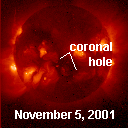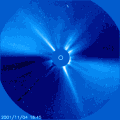|   SPACE WEATHER SPACE WEATHER
Current
Conditions
Solar Wind
velocity: 281.3 km/s
density:81.4 protons/cm3
explanation | more data
Updated: Today at 2245 UT
NOTE: ACE solar wind speed values, reported above, may be corrupted by the ongoing radiation storm. Check the SOHO Proton Monitor for current wind speed estimates.
X-ray Solar Flares
6-hr max: C8 1805 UT Nov05
24-hr: M1 0915 UT Nov05
explanation | more data
Updated: Today at 2245 UT
Daily Sun: 05 Nov '01 
Sunspot 9684 has developed a delta class magnetic field that poses a threat for additional X-flares. Active regions 9682 and 9687 have gamma-class magnetic fields that harbor energy for M-class eruptions. Image credit: SOHO/MDI
The Far Side of the Sun
This holographic image reveals no large spots on the far side of the Sun. Image credit: SOHO/MDI
Sunspot Number: 186
More about sunspots
Updated: 04 Nov 2001
Radio Meteor Rate
24 hr max: 19 per hr
Listen to the Meteor Radar!
Updated: 05 Nov 2001 Interplanetary Mag. Field
Btotal: 17.8 nT
Bz: 14.9 nT south
explanation | more data
Updated: Today at 2246 UT Coronal Holes:

A small coronal hole is crossing the Sun's central meridian. Solar wind gusts from the hole could hit Earth's magnetic field as early as Tuesday or Wednesday. Image credit: Yohkoh Soft X-ray Telescope.
More about coronal holes
 SPACE WEATHER SPACE WEATHER
NOAA
Forecasts
Solar Flares: Probabilities for a medium-sized (M-class) or a major (X-class) solar flare during the next 24/48 hours are tabulated below.
Updated at 2001 Nov 05 2200 UT
| FLARE | 0-24 hr | 24-48 hr | | CLASS M | 80 % | 80 % | | CLASS X | 25 % | 25 % |
Geomagnetic Storms: Probabilities for significant disturbances in Earth's magnetic field are given for three activity levels: active, minor storm, severe storm
Updated at 2001 Nov 05 2200 UT Mid-latitudes | 0-24 hr | 24-48 hr | | ACTIVE | 30 % | 50 % | | MINOR | 40 % | 25 % | | SEVERE | 30 % | 05 % |
High latitudes | 0-24 hr | 24-48 hr | | ACTIVE | 20 % | 25 % | | MINOR | 30 % | 35 % | | SEVERE | 50 % | 35 % |

Web server provided by
VPS Hosting
| What's Up in Space -- 5 Nov 2001
Subscribe to Space Weather News! AURORA WARNING: Although the fast-moving coronal mass ejection (CME) en route to Earth has not yet arrived, a moderate geomagnetic storm is already underway. The interplanetary magnetic field near Earth has turned south and weakened our planet's defenses against solar wind gusts. This condition sets the stage for possible widespread auroras when the anticipated CME sweeps past our planet.  HERE COMES THE SUN: Twisted magnetic fields near sunspot 9684 erupted Sunday, Nov. 4th, at approximately 1620 UT. The explosion sparked an X1-class solar flare and hurled a bright coronal mass ejection (pictured right) toward Earth. The expanding cloud could trigger geomagnetic activity and Northern Lights when it hits our planet's magnetic field on Nov. 6th. HERE COMES THE SUN: Twisted magnetic fields near sunspot 9684 erupted Sunday, Nov. 4th, at approximately 1620 UT. The explosion sparked an X1-class solar flare and hurled a bright coronal mass ejection (pictured right) toward Earth. The expanding cloud could trigger geomagnetic activity and Northern Lights when it hits our planet's magnetic field on Nov. 6th.
SEVERE RADIATION STORM: Large numbers of protons accelerated by the approaching coronal mass ejection are streaming past our planet, triggering a severe S4-category solar radiation storm. The "snow" in the SOHO coronagraph animation above is a result of these energetic protons peppering the spacecraft's CCD cameras. [more information]

Above: The flux of energetic protons near our planet soared 10,000-fold after a solar explosion on Nov. 4th. SUNSPOT RISE: Using an Olympus digital camera, amateur astronomer Gunther Groenez captured this lovely image (below) of sunrise over Belgium on Nov. 2nd. Visible on the face of the Sun are the large sunspots 9682 and 9684. Click to view the a full-sized photo.  WEB LINKS: NOAA FORECAST | GLOSSARY | SPACE WEATHER TUTORIAL | LESSON PLANS | BECOME A SUBSCRIBER | 
Potentially Hazardous Asteroids (PHAs) are space rocks larger than approximately 100m that can come closer to Earth than 0.05 AU. None of the known PHAs are on a collision course with our planet, although astronomers are finding new ones all the time.
On 5 Nov 2001 there were 340 known Potentially
Hazardous Asteroids Nov. - Dec. 2001 Earth-asteroid encountersNotes: LD is a "Lunar Distance." 1 LD = 384,401 km, the distance between Earth and the Moon. 1 LD also equals 0.00256 AU. MAG is the visual magnitude of the asteroid on the date of closest approach. 
- PERSEIDS 2001: Perseid watchers on August 12th spotted meteors, auroras, and a disintegrating Russian rocket! [gallery]
- MORNING PLANETS: In July and Aug. 2001, the Moon, Jupiter, Saturn, Venus, and Mercury put on a dazzling early-morning sky show. [gallery]
- C/2001 A2 (LINEAR): This volatile comet is still visible through small telescopes as it recedes from Earth. [gallery]
- ECLIPSE SAFARI: Onlookers cried out in delight on June 21, 2001, when the Moon covered the African Sun, revealing the dazzling corona. [gallery]
- TOTAL LUNAR ECLIPSE: On Jan. 9, 2001, the full Moon glided through Earth's copper-colored shadow. [gallery]
- CHRISTMAS ECLIPSE: Sky watchers across North America enjoyed a partial solar eclipse on Christmas Day 2000 [gallery]
- LEONIDS 2000: Observers around the globe enjoyed three predicted episodes of shooting stars. [gallery]
 July 27, 2001: Meteorites Don't Pop Corn -- A fireball that dazzled Americans on July 23rd probably didn't scorch any cornfields, contrary to widespread reports. June 12, 2001: The Biggest Explosions in the Solar System -- NASA's HESSI spacecraft aims to unravel an explosive mystery: the origin of solar flares. Feb. 21, 2001: Nature's Tiniest Space Junk -- Using an experimental radar, NASA scientists are monitoring tiny but hazardous meteoroids that swarm around our planet. Feb. 15, 2001: The Sun Does a Flip -- NASA scientists who monitor the Sun say our star's enormous magnetic field is reversing -- a sure sign that solar maximum is here. Jan. 25, 2001: Earth's Invisible Magnetic Tail -- NASA's IMAGE spacecraft, the first to enjoy a global view of the magnetosphere, spotted a curious plasma tail pointing from Earth toward the Sun. Jan. 4, 2001: Earth at Perihelion -- On January 4, 2001, our planet made its annual closest approach to the Sun. Dec. 29, 2000: Millennium Meteors -- North Americans will have a front-row seat for a brief but powerful meteor shower on January 3, 2001. Dec. 28, 2000: Galileo Looks for Auroras on Ganymede -- NASA's durable Galileo spacecraft flew above the solar system's largest moon this morning in search of extraterrestrial "Northern Lights" Dec. 22, 2000: Watching the Angry Sun -- Solar physicists are enjoying their best-ever look at a Solar Maximum thanks to NOAA and NASA satellites. MORE SPACE WEATHER HEADLINES |

